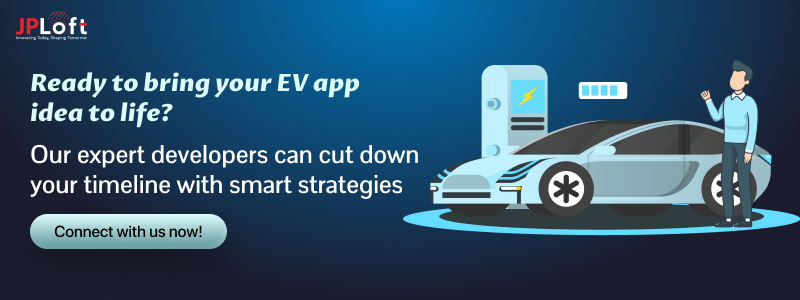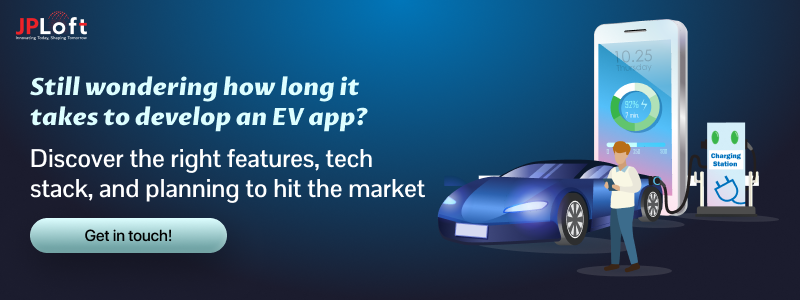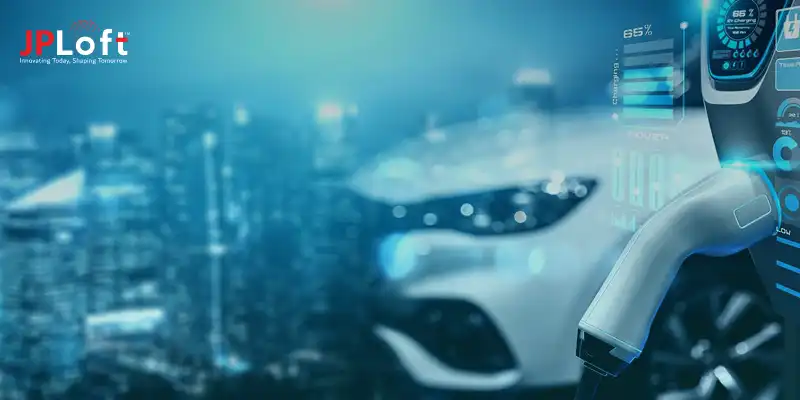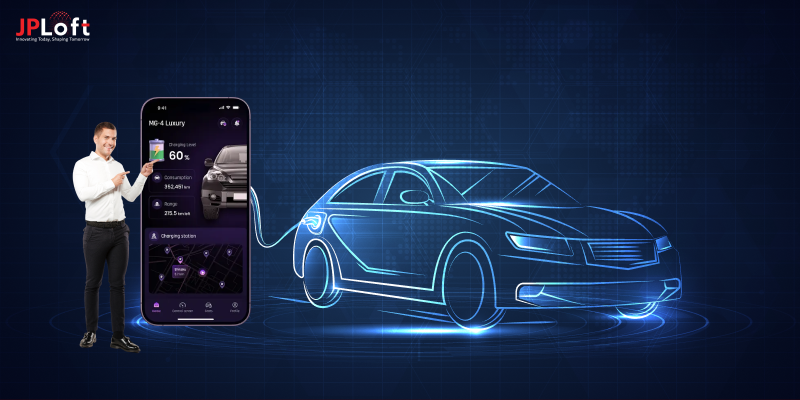When business owners and startup enthusiasts plan to develop an EV app, one common question they always ask is “how long does it take to develop an EV app”.
On average, the timeframe to develop an EV app typically ranges between 3 to 9 months.
The Electric Vehicle app development time can vary depending on features, complexity, and technology integrations.
With the rapid growth of electric vehicles, mobile apps have become essential, helping users locate charging stations, plan trips, and manage fleet performance.
By understanding the electric vehicle app development time, companies can estimate timelines more accurately, plan their launch strategically, and ensure their app stands out in the competitive EV market.
Key Takeaways
EV app development can take anywhere from 3 months for basic apps to 9 months for enterprise-grade solutions, depending on features and scope.
App complexity, design, tech stack, platform choice, team expertise, and testing cycles directly influence development time.
From market research and design to frontend/backend development, integrations, testing, and launch, each stage requires careful planning.
The longer and more complex the project, the more extended the development timeline becomes, while MVPs offer a faster and time-efficient entry.
Defining clear scope, using cross-platform frameworks, starting with MVP, leveraging APIs, and continuous testing help optimize both time and cost.
As a trusted app development company, JPLoft delivers scalable, secure, and feature-rich EV apps with end-to-end support, helping businesses launch faster and succeed in the growing e-mobility market.
Average Timeframe to Develop an EV App
When estimating the average time to develop an EV app, the timeline depends on the stages of app development, features of EV apps, and complexity.
If you’re wondering how much time does it takes to build an EV app, the answer is, it generally ranges between 3 to 9 months, depending on project scope.
Here’s a quick breakdown:
|
Type of EV App |
Features Included |
Average Timeframe |
|
Basic EV App |
Essential features like charging station locator, user login, simple UI/UX |
3–4 months |
|
MVP (Minimum Viable Product) |
Core features for quick market testing; limited integrations |
10–12 weeks |
|
Advanced EV App |
Smart navigation, payment systems, real-time analytics, IoT-based charging, notifications |
6–9 months |
|
Enterprise-Grade EV App |
Scalable solution with AI-powered recommendations, advanced security, multiple integrations |
9–12+ months |
Several factors affecting EV app development time include UI/UX design, backend architecture, third-party integrations, and compliance with app store requirements. So, the answer to the question “how long does it take to develop an Electric Vehicle app” is your project scope, business goals, and the balance between speed and quality.
Step-by-Step EV App Development Process & Timeline
If you’re wondering how long does it take to develop an Electric Vehicle app, the answer lies in understanding the complete journey from idea to launch.
The EV app development time doesn’t have a one-size-fits-all answer, it depends on your app’s complexity, required features, and chosen platforms.
On average, the time can range anywhere from 3 to 9 months. To help you plan better, here’s a detailed look at the stages of electric vehicle app development and the estimated timeline for each.
Step 1: Market Research & Planning (1–2 Weeks)
Before diving into design or coding, the very first step is understanding the market and users. This stage lays the foundation for the entire project and helps avoid costly mistakes later.
The insights gained here don’t just guide the design and features but also influence the overall direction of development. Spending adequate time in this stage ensures the app is built around real user needs rather than assumptions.
Estimated time: 1–2 weeks
Step 2: Wireframing & UI/UX Design (2–4 Weeks)
Once the planning is complete, the next step is creating wireframes and designing the app’s interface. This stage is also known as app wireframing, where the structure and flow of the application are mapped out visually.
In many cases, app prototyping is also done to give stakeholders a feel of how the app will function before coding begins. While design might feel like a creative step, it’s also highly technical, because the decisions made here will affect development later, thereby impacting the overall timeline.
Estimated time: 2–4 weeks
Step 3: Frontend & Backend Development (6–10 Weeks)
This is where your idea starts becoming reality. Developers begin coding both the frontend (what users see) and backend (server-side logic).
If you’re asking how long does it take to develop an electric vehicle app, this is usually the stage that takes the most time. The more complex your app features are, the longer the development cycle will be.
Estimated time: 6–10 weeks
Step 4: API Integrations & Feature Implementation (2–4 Weeks)
Modern EV apps rely on multiple integrations to deliver value. At this stage, developers connect the app with third-party APIs and add specialized functionalities.
For entrepreneurs planning to develop an app like Plugshare, this is also where you would add community-driven features, such as allowing users to update charger availability.
Estimated time: 2–4 weeks
Step 5: Testing & Quality Assurance (3–5 Weeks)
No app can succeed without rigorous testing. This stage ensures your app works seamlessly across devices, locations, and network conditions. Many businesses underestimate this step, but skipping or rushing QA often leads to delays later.
A strong testing phase reduces bugs, enhances security, and ensures a smooth user experience, which is critical when competing with the best electric vehicle charging apps in the market.
Estimated time: 3–5 weeks
Step 6: Launch & Deployment (1 Week)
After successful testing, the app is finally ready to go live. This stage is all about making your product accessible to users on different platforms.
During this phase, you need to submit an iOS app in the App Store, which involves meeting Apple’s strict review and compliance requirements. Also, publish an app in the Google Play Store, ensuring it follows Google’s policies.
Estimated time: 1 week
Step 7: Post-Launch Support & Updates (Ongoing)
The launch isn’t the end, it’s just the beginning. Once users start downloading your app, their feedback and behavior will guide your future improvements. Regular updates and app maintenance service are essential to keep the app relevant, competitive, and aligned with evolving EV market needs.
One of the factors affecting EV app development time in the long term is how frequently updates are rolled out. The more dynamic, user-focused, and consistent your update cycle, the higher the chances of your app standing out in a crowded market.
Estimated time: Continuous (weekly to quarterly updates)
The mobile app development time for electric vehicles is shaped by design, features, integrations, and testing. By carefully analyzing the stages of electric vehicle app development, you can set realistic goals and avoid unnecessary delays.
A clear roadmap also helps in managing resources better and ensures that the final product aligns with user expectations. Ultimately, proper planning saves both time and cost in the long run.
Factors That Affect EV App Development Time
When entrepreneurs and startups step into the EV industry, one of the first questions they ask is: “How long does it take to develop an electric vehicle app?” The truth is, the timeline isn’t universal.
The EV app development time can range from 3 months for a basic app to nearly 9 months for complex, feature-rich solutions.
To estimate your own, it’s important to understand the factors that directly influence the timeline. Let’s explore them one by one:
A] App Complexity & Features
A simple EV app with limited features like charging station locators or battery status monitoring may take 3–4 months to develop.
However, if you’re building an advanced solution with real-time vehicle tracking, route optimization, payments, or AI-based smart charging, the timeline can extend to 8–12 months. This is why many startups prefer launching an MVP first, then gradually scaling it.
B] Design & User Experience
The design stage is one of the most underestimated parts of electric vehicle app development. A user-friendly interface, interactive maps, and smooth navigation take time to design and test.
While this may add weeks to your development cycle, it plays a major role in keeping users engaged.
C] Technology Stack & Integrations
The tools and technology you choose have a direct impact on the timeline. For example, integrating APIs for GPS navigation, IoT sensors for charging data, or secure payment gateways can be time-intensive.
If you are specifically wondering how long does it take to create an EV charging app, integrations like real-time station availability and payment systems often determine the bulk of development time.
D] Platform Choice
Deciding whether to launch on iOS, Android, or both affects not just cost but also time. Cross-platform frameworks like Flutter can speed up development, but native apps often provide more stability and scalability, something critical if you’re planning to start a mobile EV charging business.
E] Development Team & Expertise
The experience of your developers makes a huge difference. A skilled team with prior expertise in electric vehicle software development can cut down the timeline significantly compared to a team learning on the go.
F] Testing & Quality Assurance
No matter how fast the development is, thorough app testing is essential. This is one of the most important stages that ensures your app is secure, bug-free, and capable of handling high traffic.
Testing can take 3–6 weeks depending on the app’s complexity.
Ultimately, the EV app development time varies widely based on these factors. If you are exploring unique EV app ideas or planning a large-scale solution, factoring in these elements early helps set realistic deadlines and budgets while ensuring a smoother launch.
How Development Cost is Linked to Timeline?
Whenever businesses ask how long does it take to develop an EV app, the next important consideration is cost. The truth is simple, the development timeline and cost are directly linked.
The longer the app takes to build, the higher the expenses, as more resources, design iterations, and testing are required. If you are estimating the cost to build an EV software, it’s essential to understand how different timelines impact overall investment.
Here’s how various timelines affect the cost:
|
Development Type |
Average Timeline |
Estimated Cost (Relative) |
Key Highlights |
|
Basic Development |
3 – 4 months |
Low |
Essential features only (user accounts, station locators). Best for startups to validate ideas. |
|
MVP Approach |
4 – 5 months |
Low to Medium |
Focuses on core features for fast market entry & early feedback. Excludes non-essential extras. |
|
Intermediate Development |
5 – 6 months |
Medium |
Adds extra functionalities like user profiles, booking management, and basic analytics. Balances time and features. |
|
Advanced Development |
6 – 7 months |
Medium to High |
Includes IoT, AI, real-time analytics, and multi-layer payments. Competitive and feature-rich. |
|
Feature-Rich Development |
7 – 8 months |
High |
Adds AR/VR, advanced reporting, multiple integrations, and enhanced UX. |
|
Enterprise-Grade Solutions |
8 – 9 months |
Very High |
Scalable, AI-driven personalization, global operations, continuous updates. |
So, the development cost is always tied to the timeline. The more complex and feature-rich the app, the longer it will take and the higher the investment required.
Startups often prefer shorter timelines with basic builds or MVPs to save money, while enterprises are prepared to spend more time and budget to achieve scalability and long-term success.
Best Practices to Reduce EV App Development Time
Many businesses wonder how long does it take to develop an Electric Vehicle app, and the truth is, it depends on multiple factors.
While the average time to develop an EV app may range from a few months to nearly a year, following smart strategies can help reduce delays, save money, and speed up the launch.
Here are some best practices:
1. Define a Clear Scope & Prioritize Features
One of the biggest factors affecting EV app development time is scope creep. When new features are added mid-way, it extends both the timeline and the budget. To avoid this, clearly define the app’s purpose, target users, and must-have features from the start.
Businesses looking to build an EV charging station finder app, should focus first on core functions like charging station maps, payments, and booking slots before adding advanced features.
2. Choose the Right Tech Stack & Framework
Your choice of the app tech stack has a direct impact on both speed and efficiency. A modern tech stack, reusable components, and cross-platform frameworks like Flutter or React Native can cut weeks off the timeline.
A well-structured development plan ensures that EV app development cost and timeline remain under control without compromising performance.
3. Start with an MVP (Minimum Viable Product)
Instead of waiting months to build a full-fledged app, create an app with an MVP that includes only the most critical features.
This approach allows you to enter the market faster, test user behavior, and gather feedback for future updates. By doing so, companies can reduce the average time to develop an EV app while still making a strong market impact.
4. Leverage Agile Development & Parallel Workflows
Adopting agile methodologies and running parallel workflows, such as design and backend development simultaneously, helps reduce bottlenecks. Frequent sprints, iterative releases, and user testing make the process more efficient.
This not only saves time but also provides better visibility into how long each stage will take, ensuring a smoother EV app development cost and timeline management.
5. Use Pre-Built APIs and Third-Party Integrations
Custom development for every single feature can stretch timelines unnecessarily. Instead, leveraging pre-built APIs for maps, payment gateways, and authentication can drastically cut development time.
By integrating reliable third-party services, businesses can deliver faster without compromising quality. This is especially helpful when the goal is to launch quickly while managing both cost and time effectively.
6. Maintain Continuous Testing & QA
Testing at the end of development often leads to last-minute issues and delays. Instead, incorporating continuous testing throughout the process ensures that bugs are identified early and fixed immediately.
Additionally, using a reliable mobile app maintenance service ensures ongoing updates and smooth performance. This proactive approach prevents bottlenecks and keeps the time frame for EV app development on track while also improving the app’s reliability.
In short, reducing development time requires clear planning, smart technology choices, pre-built integrations, and continuous testing. By following these practices, businesses can optimize their EV app development cost and timeline and launch faster without compromising on performance.
Challenges in Estimating EV App Development Time
Estimating how long does it take to develop an Electric Vehicle app is never straightforward. Multiple variables come into play, and each can significantly impact the EV app development cost and timeline.
Here are the some important challenges:
► Unclear Scope and Changing Requirements
When project goals aren’t well-defined, new features get added mid-way. This scope creep increases the mobile app development time for electric vehicles and inflates costs.
► Complex Feature Integrations
Advanced functionalities like IoT charging, smart navigation, or AI-driven recommendations add complexity. These factors are among the key challenges in estimating the average time to develop an EV app.
► Third-Party Dependencies
Many businesses choose to develop an Electric Vehicle app using third-party APIs for maps, payments, and authentication. However, delays in these integrations can affect the overall time frame for electric vehicle app development.
► Testing & Compliance Delays
Ensuring app security, performance, and compliance with regulations (like app store guidelines) can add weeks to the schedule. This is one of the most unpredictable factors affecting EV app development time.
► Team Size and Expertise
The development team’s efficiency directly impacts timelines and EV app development cost. You can hire dedicated developers to speed up delivery and ensure quality results.
In short, estimating the EV app development time requires careful consideration of all these challenges. The more complex and feature-rich the app, the harder it becomes to define an exact timeline.
Future Trends Impacting EV App Development Timeline
As the EV industry evolves, so do the apps that power it. Businesses often ask not just “How long does it take to develop an Electric Vehicle app?” but also how future technologies might influence the timeline.
Below are some of the most impactful EV app development trends shaping the future:
► AI-Powered Personalization
One of the biggest EV app trends is the integration of artificial intelligence. From predicting charging needs to suggesting the nearest available station, AI shortens user journeys but increases development time due to advanced algorithms.
► IoT & Smart Charging Integration
Apps are now connecting directly with vehicles and charging stations through IoT. While this makes the app smarter, it requires more testing and APIs, adding a few weeks to the overall development timeline.
► Blockchain for Secure Payments
With growing demand for transparency, blockchain is being adopted in EV apps for secure, traceable payments. However, incorporating this technology extends both development and testing phases.
► 5G-Enabled Real-Time Features
5G allows EV apps to deliver instant updates on charging availability, traffic, and routes. Leveraging 5G improves app performance but also demands additional optimization, slightly impacting delivery schedules.
► AR/VR for Enhanced User Experience
As EV app trends evolve, some apps are experimenting with AR navigation or VR-based EV tutorials. Businesses aiming to build an AR/VR app within the EV space can deliver unique experiences, but these innovations significantly lengthen the design and prototyping phases.
► Green Tech & Sustainability Features
Many EV apps now include eco-tracking, monitoring carbon savings or optimizing routes for lower emissions. Though valuable, such features require advanced calculations and third-party integrations, extending timelines.
These future-driven innovations bring immense opportunities but also add layers of complexity to the process. Businesses planning an EV app should factor in these trends while estimating timelines to stay ahead in the competitive electric mobility market.
Why Choose JPLoft for Your EV App Development Journey?
At JPLoft, we don’t just build apps, we create digital experiences that power the future of mobility. As a top Electric Vehicle software development company, we specialize in crafting scalable, secure, and feature-rich EV apps tailored to your business goals.
From charging station finders to payment integrations and real-time analytics, our solutions cover every stage of the EV ecosystem. What sets us apart is our expertise in blending user-centric design with powerful backend systems, ensuring your app is not only functional but also future-ready.
Whether you’re a startup exploring the latest EV app in the market or an enterprise aiming to dominate the market, we provide end-to-end support, from strategy and design to launch and ongoing maintenance.
With us, you don’t just get an app, you get a growth partner driving innovation in e-mobility.
Final Wrap-Up
When entering the EV market, one of the first questions businesses ask is: “How long does it take to develop an EV app?” The answer depends on multiple factors like design complexity, feature set, integrations, and testing.
By understanding the complete process and carefully managing each stage, you can set realistic expectations and avoid costly delays. From market research to post-launch updates, every step plays a vital role in ensuring your app is competitive and user-friendly.
The key is to balance quality with efficiency while keeping users’ needs at the core. Whether you’re a startup or an established enterprise, investing in a structured development plan ensures long-term success in the fast-evolving EV industry.
FAQs
On average, it takes 3–9 months depending on features, design complexity, and integrations. More advanced apps may take longer.
Key factors include app design, feature set, third-party integrations, testing cycles, and compliance with app store guidelines.
Yes, by using ready-made APIs, focusing on an MVP (Minimum Viable Product), and hiring an experienced EV app development team, you can reduce timelines.
The cost varies based on scope and features. A basic EV app may cost less, while feature-rich solutions with advanced integrations will require a larger budget.
Absolutely. Continuous updates, bug fixes, and feature enhancements are essential to keep your app competitive in the evolving EV market.













Share this blog